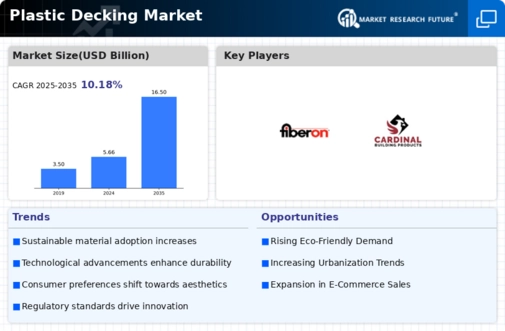Market Analysis
In-depth Analysis of Plastic Decking Market Industry Landscape
The Plastic Decking market is shaped by dynamic factors that influence the production, demand, and applications of decking materials made from plastic composites. Plastic decking, often composed of recycled materials such as polyethylene or polyvinyl chloride (PVC), offers a durable and low-maintenance alternative to traditional wood decking. The market dynamics are intricately linked to factors such as consumer preferences, environmental sustainability, technological advancements, and the construction and remodeling industry.
The plastic decking products are low cost and low maintenance. It is a crucial benefit of the product that offers plenty of market growth opportunities. In the upcoming years, industrialization will rise massively. The need to manufacture and produce industrial items will be enormous. During all these processes the plastic decking will be used. Also, the properties of the plastic decking are suitable for any industrial purpose.
One of the key drivers of the Plastic Decking market is the increasing popularity of low-maintenance and long-lasting outdoor decking solutions. Plastic decking materials are known for their resistance to rot, decay, and insects, making them an attractive choice for homeowners seeking a durable and hassle-free outdoor living space. The demand for plastic decking is driven by the desire for a product that requires minimal upkeep, reducing the need for staining, sealing, or regular maintenance associated with traditional wood decks.
Consumer preferences for sustainable and eco-friendly materials contribute significantly to the market dynamics of Plastic Decking. As environmental awareness grows, consumers are increasingly choosing decking materials made from recycled plastics. The use of recycled content in plastic decking aligns with sustainability goals, reducing the reliance on virgin plastics and promoting the circular economy. Manufacturers responding to these preferences often incorporate recycled materials into their plastic decking products.
The construction and remodeling industry plays a pivotal role in shaping the market dynamics of Plastic Decking. As homeowners and builders seek versatile and durable decking materials, plastic composites gain popularity for outdoor applications. The market is driven by new construction projects as well as the replacement of existing decks with low-maintenance and weather-resistant plastic decking solutions.
Technological advancements in plastic composite manufacturing contribute to the market dynamics, allowing for the development of decking materials with improved performance characteristics. Innovations in composite formulations, manufacturing processes, and surface treatments enhance the strength, color retention, and texture of plastic decking products. Manufacturers strive to stay competitive by incorporating the latest technologies into their products, meeting the evolving demands of the decking market.
Supply dynamics in the Plastic Decking market are influenced by factors such as the availability and cost of raw materials, recycling capabilities, and manufacturing capacities. The plastic recycling industry, responsible for processing post-consumer plastics into composite materials, plays a significant role in determining the overall supply chain dynamics. Additionally, global trade dynamics, including tariffs and transportation costs, impact the availability of plastic decking in different regions.
Global trade dynamics are significant in the Plastic Decking market, with many countries involved in both the production and consumption of plastic decking products. Trade agreements, tariffs, and regional economic conditions can impact the flow of plastic decking across borders. The market is also influenced by competition among manufacturers to offer innovative decking solutions with enhanced aesthetics, durability, and sustainability features.
Regulatory standards and certifications play a vital role in shaping the market dynamics of Plastic Decking. Standards related to product safety, fire resistance, and environmental impact influence the design and production of plastic decking materials. Manufacturers must comply with these standards to ensure the quality and performance of their products and gain market acceptance.
Price volatility is a common factor in the Plastic Decking market, driven by fluctuations in raw material prices, manufacturing costs, and market demand. Companies in this dynamic market must implement effective pricing strategies and risk management practices to navigate the uncertainties associated with price variations.


 Source: Secondary Research, Primary Research, Market Research Future Database and Analyst Review
Source: Secondary Research, Primary Research, Market Research Future Database and Analyst Review


Leave a Comment